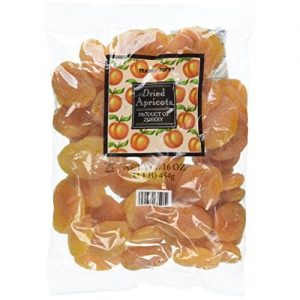
Dried Apricots
Main ingredient: Apricots
Before coming back to school, I picked up some snacks at Trader Joe’s, including dried apricots. As stated on the packaging, the apricots were a product of Turkey. Turkey is the largest producer of apricots, and generally apricots are native to parts of Asia. However, the fruit is grown worldwide in countries including France, Armenia, Morocco, and various parts of the United States including California. Therefore, my dried apricots traveled approximately 5,500 miles to get to my plate. Dried fruit is made by either taking the water out of the fruit by sun drying or through using a machine called a dehydrator. As a result of the water taken out, sugars are more concentrated in this dried fruit. The environmental impact of apricot production is considered relatively low with 1,287 liters of water used to produced 1 kilogram of apricots, however, the distance of the apricots from Turkey would definitely increase the environmental impact.

Broccoli
Main ingredient: Broccoli
Broccoli is one of my favorite foods.
I ate broccoli in the caf, and therefore am not entirely sure where my broccoli came from. However, in the United States, the main producing states include California, Arizona, Texas, and Oregon. Since California produces 90 percent of the country’s broccoli production, I will assume the broccoli came from there. My broccoli traveled approximately 2,700 miles to get to my plate. Most broccoli harvested in the US is sold as fresh produce, however, the broccoli I ate in the caf was likely frozen. Pesticides and other chemicals were likely used in the production process. Out of the three foods, I selected, broccoli has the smallest water footprint, approximately 285 liters of water used to produce one kilogram of broccoli with a low average carbon footprint as well/

Peanut Butter:
Main ingredient: Peanuts
For my first- year seminar “Food Justice”, I did an assignment in which I had to try to figure out where everything I ate came from for a week. In the process of hassling the cafeteria staff about many products, I recall learning that the caf uses Jif peanut butter- both the regular and natural options. Jif peanut butter is produced at a facility in Lexington, Kentucky, the largest peanut butter production facility in the world. Their peanuts primarily come from farms in the south of the United States including Alabama, Georgia, Florida, and South Carolina. From the farms, my peanuts travelled approximately 1,000 miles, though the whole journey would likely be more miles after taken in consideration the mileage to and from production plants. Though peanut production is water intensive, according to UNESCO-IHE Institute for Water Education, the global average water footprint of peanuts is approximately 2,782 cubic meters per ton of nuts is less compared to other nuts, for instance almonds which use an average of 8,047 cubic meters of water used per ton of nuts- though peanuts are technically legumes not nuts which is why their impact is substantially smaller.
Though I try to be conscious of my food consumption and carbon footprint in some respects due to eating primarily vegetarian/ plant-based options, I realized through this exercise that I am less conscious of my decisions at school, even in comparison to when I am home on breaks where I can more easily make personal decisions. At Dickinson, we are required to have meal plans, therefore we are less autonomous in our decision- making process.
Leave a Reply